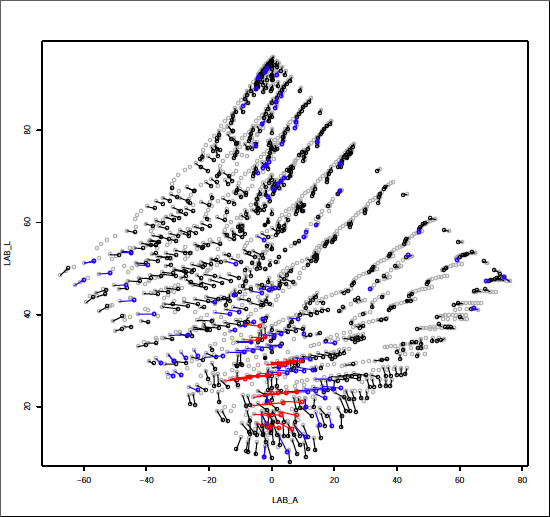
fo39vs27-aL.pdf
Here they are, the “Christmas gifts” made by the FOGRA: the new characterisation data for ISO 12647-2:2004 / Amd 1 “FOGRA39”. The associated profiles from the ECI “ISO Coated v2 (ECI)” and “ISO Coated v2 300 (ECI)” will be available in the beginning of January.
In order to get a first impression, I compared the new and old characterisation data using R. The following pictures show the differences between FOGRA27 and FOGRA39 in 3 CIE L*a*b* planes (aL, bL and ab).
FOGRA27 chromaticity coordinates are drawn as grey circles, FOGRA39 chromaticity coordinates as black, blue or red circles. The lines connect the same CMYK values in FOGRA27 and 39.
The color of the lines classifies the color difference (DELTA E 2000):
Obviously the strongest differences appear in the range of dark grey and blue shades, which are shifted towards magenta.
The average of all values with ΔE00>5 results in a CMYK value of 96/91/72/14, Lab 24.6/4.3/6.8 for FOGRA27 and Lab 24.5/1.3/7.9 for FOGRA39. The most significant change is a shift of Δa 5.5 towards magenta.
A more detailed review of the ECI2002 tables shows that these changes are manly caused by the new grey balance and the modified chromaticity coordinates for blue:
The CMYK value 100/100/100/0 was apparently greenish (C = 7, h = 170°) and is now perfectly neutral (C = 0). With a ΔE00 of 7.4 it is on rank 4 of 1457 in a table ordered by Delta E 2000 descending.
Rank 1 to 3 goes to the CMYK values 100/100/70/0, 100/100/70/20 and 100/100/85/0 — very dark shades of blue with few or no black. Their ΔE00 amounts to 8.2 through 7.9. The brightness is hardly changed (ΔL 0.2…0.7), but with ΔH = 6 they are obviously more violet.
Rank 19 shows a dark shade of green for the first time: CMYK 100/85/100/0 becomes substantially more neutral with ΔE00 = 5.4 and ΔC = -6.7 in FOGRA39 due to the changed grey balance.
Rank 28 (CMYK 100/100/0/20) is the first color with maximum black composition: its ΔE00 amounts to 4.6 and with ΔLab 0.8/5.7/1.4 it became considerably more violet.
Other shades of blue like
CMYK 100/100/0/0 (ΔE00 = 4.4/Δa = 5.8, rank 38),
CMYK 100/ 85/0/0 (ΔE00 = 4.2/Δa = 5.2, rank 45) and
CMYK 100/ 70/0/0 (ΔE00 = 4.2/Δa = 4.2, rank 89) show the same trend.
Above all, the changes in the pure colors concerns blue (ΔE00 = 4.4), the other primary and secondary colors alter to a much lesser extent (ΔE00 = 0.6…1.6).
The following gradient from cyan over blue to magenta demonstrates the practical impact of the changes. The x axis ranges from -100 (= 100% Cyan) over 0 (= 100% Cyan + 100% Magenta) to +100 (= 100% Magenta), the y axis shows the hue angle in degrees.
100C/80M (x = -20) corresponded to a hue of approx. 276° in FOGRA27. The same hue is equivalent to x = -27, thus 100C/73M in FOGRA39.
The Lab TIF“fo27vs39.tif“ (1,9MB) shows all colors of the ECI2002 chart for FOGRA27 and FOGRA39 ordered by ΔE00 descending in direct comparison.
The 3D color space comparison shows that FOGRA39 (represented as wireframe) exceeds FOGRA27 particularly in shades of dark red/magenta and black.
Therefore proof suppliers should check whether the gamut of their system is sufficient for FOGRA39 in this regions. (The UGRA/FOGRA media wedge is not suitably for this purpose since it contains no colors like 100/100/40/100.) More reliable statements can be obtained with a comparison of the proofer profile with ISO Coated v2 in 3D, e.g. with ICCView, ArgyllCMS or ICC Examin. Questionable areas should be examined visually afterwards, e.g. with suitable gradients like those from black to 100/100/0/100 or 0/100/100/100 (CMYK TIFs for download).
Unfortunately there are no reference prints available for FOGRA39 (not yet?), which would provide a way to verify and/or fine-tune a proofing system visually.
The example below shows that adjustments are necessary in some case, in order to correct the shift towards magenta in sensitive shades of blue and grey on images present only in CMYK. These adjustments can take place manually or with (device link) profile conversions, however they are always tied to slight losses in quality. In contrast, media-independent files can be re-used without problems for FOGRA39.
Print shops will surely be pleased with the new reference data and profiles: The problems they had with the FOGRA27 blue now certainly belongs to the past. DnS (german page) showed that the new grey balance can be reached obviously without difficulties. Surely not only web offset printers will rejoice in the lower ink limit (300 or 330 instead of 350%) of the new ECI Profiles. IMO only the mix of old and new data can cause problems in this context.
So far my first impression. All statements above give an account of my personal, private opinion only. I am pleased to recieve suggestions, criticism, questions, corrections (particularly concerning my poor translation ;-), etc. by email to k@archer@digitalproof.fake@invalid.cominfo at any time.
Klaus Karcher, Dec 22, 2006
last update: Dec 23, 2006